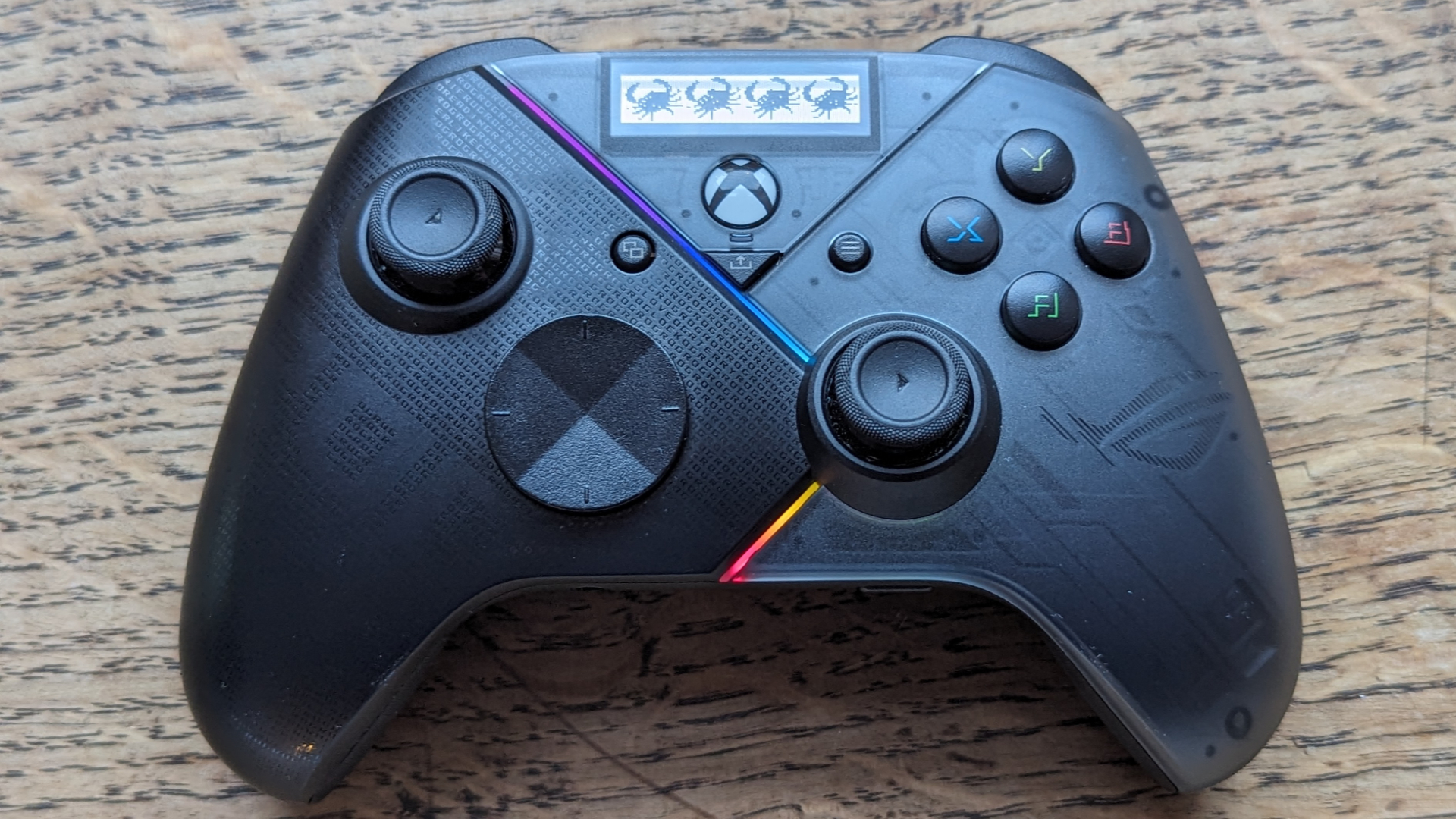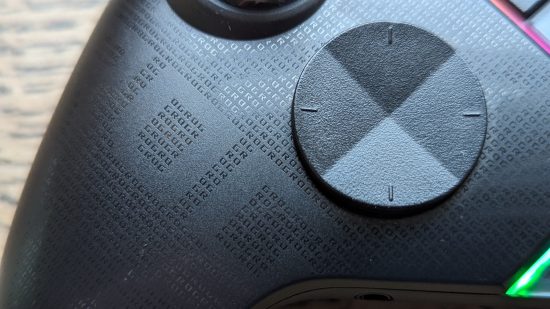The first emotion I felt when hearing about the Asus ROG Raikiri Pro was curiosity. It looks great, has programmable back buttons and customizable triggers, and can connect through wireless dongle, Bluetooth, and USB-C. So far, so good. It’s also got a whacking great price tag.
But the main thing that drew me in is the novel OLED screen. I’m often skeptical of products that put flashy features front and center in marketing. Most of us want solid performance above anything else, and any cherries on the cake are just that. What matters is the ingredients, the nuts and bolts of what you’re making.
The Asus ROG Raikiri Pro’s ingredients aren’t always palatable, proving that skepticism was well-founded. It’s not terrible, but the OLED screen feels like a wasted opportunity, and the performance elsewhere struggles to make up for it.
Pros
- Appealing translucent look
- Lightweight 300g design and textured grip
Cons
- OLED screen offers little
- Poor d-pad design leads to inputs registering wrong or not at all
- Weak price-to-performance ratio
Asus ROG Raikiri Pro specs:
| Connection | 2.4GHz dongle, Bluetooth, USB-C, 3.5mm headphone jack |
| Platform | PC, Xbox Series X|S, Xbox One, Windows 10/11 |
| Battery | Up to 48 hours |
| Weight | 300g |
| Dimensions | 103 x 64 x 155mm |
Asus ROG Raikiri Pro design
The Asus ROG Raikiri Pro has a sleek, tasteful design similar an Xbox Series controller. Its main distinctive features are the aforementioned OLED screen that sits above the Xbox button and an angular RGB slash that arcs across the middle of the controller.
You get a standard array of Xbox controller buttons plus textured joysticks, a circular d-pad (more on that later), and four programmable back buttons. The controller is split between translucent plastic that covers the right-hand front of the controller and an opaque black design on the left with a subtle, ROG-branded pattern. It all looks decent enough, apart from the RGB. Despite a range of customization options, the controller’s lighting is mediocre and forgettable.
Asus ROG Raikiri Pro features and software
The feature that sets the Asus ROG Raikiri Pro apart from the crowd is its mini screen, so let’s talk about that first. While technically true, calling it an OLED screen makes it sound more impressive than it is. As a buzzword used to sell gaming monitors, its use here conjures images of a colorful, high definition display on your controller. The reality is a little different.
The screen only allows black or white, and covers just 128 x 32 pixels. The preset animations are bland gifs of the word ‘ROG’ that make you feel like you’re watching an advert. Which, I suppose, you are.
You can add custom animations, but the pixel requirements, 40kb max file size, and 60 frame maximum for gifs limit your options somewhat. Don’t think you’ll be watching Lord of the Rings on your controller anytime soon.
Aside from the animations and wallpapers, the screen shows the battery life and connection type… And that’s about it. You can change a few settings and switch between profiles you’ve already created in Armoury Crate, but can’t actually program the controller in any way. You’d think Asus would at least let you remap the back buttons with the screen, but no.
Speaking of Armoury Crate, it’s unintuitive and ugly. And probably my least favorite gaming gear software to use. If you want to customize your Raikiri Pro, you’ll need to connect through a USB-C cable. I spent ages trying to work out why it wasn’t picking up my controller when it was connected and otherwise working fine through the wireless dongle, so let me save you that hassle out of the gate.
Anyway, once you’ve connected it through USB-C, there are a range of customization options available to you. That includes the range of motion of the trigger buttons and their dead zones, thumbstick response curve, vibration strength, button assignments, and more. I can’t fault the versatility here; Asus has given settings tinkerers the full gamut of dials and sliders to meddle to your heart’s content.
The Raikiri Pro also provides the holy trinity of connection options. Whether I’m hooked up with USB-C, Bluetooth, or the included 2.4GHz dongle, I didn’t notice a difference in latency or responsiveness. Asus has also added a handy compartment to store the dongle when you’re not using it so you can take it with you on the go. Or if you’re like me, it stops you from putting it somewhere in your office and losing it.
Asus ROG Raikiri Pro performance and functionality
The first aspect I notice when picking up the Asus ROG Raikiri Pro is its weight, or lack of. At 300g, it’s firmly on the lighter end of the controller spectrum. It’s great that gaming gear design is moving on from the dated ‘heavier = better’ philosophy when it comes to controllers. The Raikiri Pro undoubtedly feels nifty in my hands.
That, coupled with the textured grips, means this controller lends itself to long gaming sessions. And the long battery life, even with the OLED screen and RGB on, compounds that further.
Most of the buttons are pretty typical for an Xbox-style controller, apart from the pleasantly textured joysticks, dainty back buttons, and poor d-pad. I often use joystick caps to make them feel more grippy, but didn’t feel the need with this controller. However, the joysticks are analog rather than Hall effect and aren’t easily replaceable. I didn’t experience any drift during my several months with the Raikiri Pro. But if you did, you’d have a big problem.
The philosophy behind the Raikiri Pro’s back buttons is that they’re in the center, rather than just directly beneath your fingers, thus avoiding accidental clicks. This justifies a lighter actuation point, which is great, as back buttons often require an inconvenient amount of force for your ring and pinky fingers.
That proves something of a double-edged sword, though, as the back buttons can feel a little insubstantial, lacking the satisfying clickiness that other controllers’ back buttons boast. They feel less natural to use than other back buttons thanks to the design choice to make them unobtrusive.
Finally, the d-pad is a real weakness. It’s a circular pad, rather than the standard plus shape. Although that’s not always a problem, in this instance, it gets in the way of precise inputs, which means it’s not fit for purpose in fighting games, especially. Also, the click when you’ve met the actuation point is unclear, meaning inputs often fail to register, even when you feel like you’ve pressed hard enough.
Asus ROG Raikiri Pro price
The Asus ROG Raikiri Pro’s $169.99 MSRP puts it firmly within the higher price bracket for PC controllers. For that price, you could pick up the excellent Xbox Elite Series 2 or buy a quality, cheaper controller and pocket the difference. The Raikiri Pro struggles to live up to its price tag, so I’d recommend picking up something from our best PC controller guide instead.
Is the Asus ROG Raikiri Pro worth it?
If you want a no-fuss, high-performing controller, you should look elsewhere. It’s a sad fact because I quite enjoyed my time with the Raikiri Pro. But it’s the truth. The D-pad is poor, the back buttons are insubstantial, and the OLED screen is pointless.
As much as the Raikiri Pro tries to convince you that it’s a premium controller, it never quite manages. It’s not necessarily bad, there are just much, much better options in the $150-200 range. If you’re dropping that much on a controller, you expect an elite experience, and the Raikiri Pro just doesn’t provide that.
Should you buy the Asus ROG Raikiri Pro?
- Yes, if you’ve got a burning desire for a controller with an OLED screen and cash to burn.
- No, if performance matters to you.
- No, if you’re a discerning consumer, as much better controllers are available at this price bracket.
If the Asus ROG Raikiri Pro isn’t for you
It may have been around for a few years now, but the Microsoft Xbox Elite Series 2 controller is still an absolute powerhouse. It may not have an OLED screen, but unlike the Asus ROG Raikiri Pro, it pushes all the right buttons elsewhere.
Alternatively, if you’re looking for something a bit cheaper but still high-end, the Nacon Revolution Unlimited is another great choice. Unlike most controllers which tend to emulate either the Playstation or Xbox design, the Nacon Revolution Unlimited opts for something in between and also brings excellent build quality and customization options too.
Asus ROG Raikiri Pro review
Despite a sleek, lightweight design working in its favor, the Asus ROG Raikiri Pro fails to justify its price tag thanks to style-over-substance design choices.






